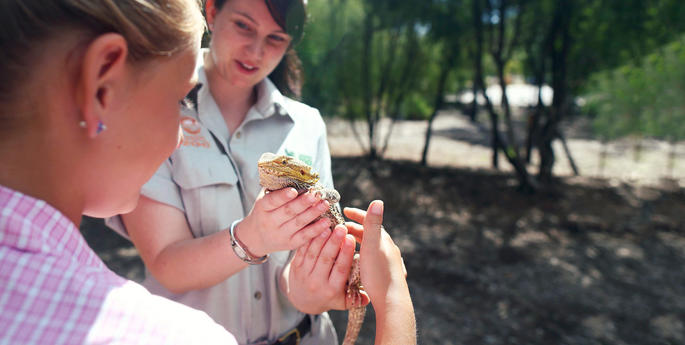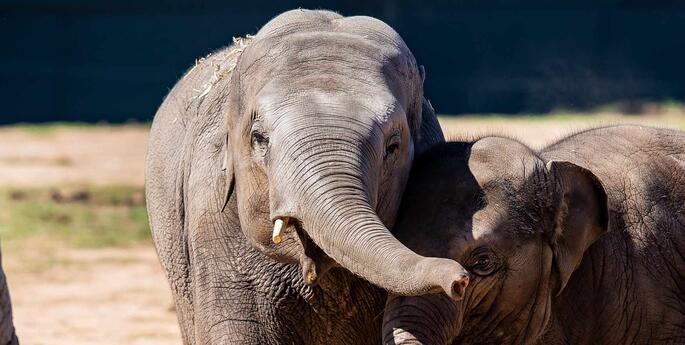Dreaming stories are an integral part of Aboriginal culture and Indigenous Australians are pioneers of sustainable land use. In this workshop, students will learn about the importance of animals and Dreaming stories to Aboriginal people, their culture and their connection to Country.
Browse all available workshops at Taronga Western Plains Zoo Dubbo below.
Looking for workshops at Taronga Zoo Sydney instead? View all Sydney workshops.
Workshops at Taronga Western Plains Zoo Dubbo
 Early Stage 1 - Stage 1: Dreaming and Living on the Land
Early Stage 1 - Stage 1: Dreaming and Living on the Land Early Stage 1 - Stage 6: Animal Encounter
Early Stage 1 - Stage 6: Animal EncounterDuring this workshop, students have the opportunity to get up close to a range of native Australian animals and learn about their needs for survival. Students will discover some of their amazing structural and behaviour features and how these adaptations help them to survive throughout their life.
 Early Stage 1: Wildlife Corridors
Early Stage 1: Wildlife CorridorsDuring this workshop students will explore how the natural environment may be divided up by human-made items, like roads, paths, and bridges. Students will learn how different animals have different needs depending on where they live in their environment (terrestrial, arboreal & fossorial). In this hands on workshop, students will learn how they can help create safe passageways for our animals by creating wildlife corridors.
 Pre School: Habitat Build
Pre School: Habitat BuildChildren will sing and dance their way through this hands on workshop while learning about habitats. They will participate in activities that will provide them with access to a range of natural materials in their environment to build habitats for animals located their local environment. While learning to model respect, care and appreciation for the natural environment.
 Stage 1: Backyard Buddies
Stage 1: Backyard BuddiesJust by exploring living things in our local environment, we can learn so much. During this workshop students will meet a range of local native Australian animals and collect and identify garden invertebrates. Students will learn how different places provide for the needs of living things and how they can help by creating habitat for wildlife.
 Stage 2 - 3: Marradir, Garay, Birdany Tour
Stage 2 - 3: Marradir, Garay, Birdany TourThis workshop is a unique, guided walking tour of the Taronga Western Plains Zoo site. Students will engage with Dreaming stories and cultural learnings while highlighting the strong connections between Aboriginal people and the natural world.
 Stage 2: Life Cycles
Stage 2: Life CyclesIn this workshop students will meet a range of Australian animals and compare their life cycles. They will discover how they can support the various needs of animals as they move through the different stages of their life cycle.
 Stage 2: The Earth's Environment
Stage 2: The Earth's EnvironmentIn this workshop students will examine the unique features of Australian and Sumatran habitats and meet some animals that depend on these environments. Students will discover the ways people value and conserve environments, including Aboriginal and Torres Strait Islander Peoples. They will learn how their everyday consumer choices impact critical environments across the globe. While in grounds, a visit to the Wild Asian Wetlands is valuable to reinforce the concepts discussed in this workshop.
 Stage 3 - 5: Exhibit Design
Stage 3 - 5: Exhibit DesignWhen designing zoo exhibits, Taronga aims to reproduce each animals natural environment. In this workshop students will learn about how the behavioural and physiological needs of an animal are the primary consideration in designing their exhibit. They will examine how animal welfare, enrichment, keeper safety, budget, visitor engagement and sustainability also significantly inform the design process and discover the range of styles that characterise modern exhibit design.
 Stage 3, 4 & 5: Zoo Nature Journal
Stage 3, 4 & 5: Zoo Nature JournalIn this workshop, students slow down and take the time to observe, draw and write about the animals and plants, both captive and wild. Find the wild birds, recognise some common native trees, learn about animal form and function, and get insights into animal behaviour.
 Stage 3: Predator and Prey
Stage 3: Predator and PreyPopulations of organisms do not remain constant; the number of individuals can increase and decrease over time. Predator and prey relationships contribute to these changes.
 Stage 4: Classification and Adaptations
Stage 4: Classification and AdaptationsIn this workshop students will explore the classification system used to identify animals and reasons for classifying organisms. They will meet some amazing native animals and develop their ability to group living organisms according to a variety of common features. Each animal’s structural and behavioural adaptations will be discussed and how they help the species survive in the harsh Australian environment.